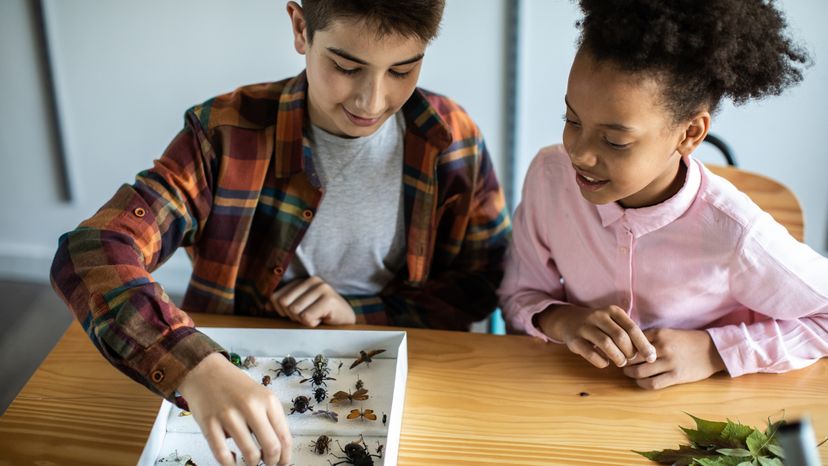A lot of insects practice preying on flies, but only in this insect experiment can kids watch the totally weird-looking praying mantis hunt down and gobble up fruit flies!
What You'll Need:
- Praying mantis egg cases
- Wingless fruit flies
- Fruit fly food
- Small aquarium or plastic container
- Soil
- Branch
- Seeds (optional)
- Small disposable cup
- Ruler
- Safety scissors
- Water
How to Do Preying on Flies:
Step 1: Order praying mantis egg cases, wingless fruit flies, and food from a biological supply company.
Step 2: Place a 1-inch layer of soil in the aquarium. Place the branch so the praying mantis can walk and hang from it.
Step 3: At the back of the tank, you may want to plant some seeds. When they grow, they will add background to the tank and give the mantises more options for hunting and hiding. Follow the instructions on the seed packet for how to plant them and give them enough water and light. (Make sure the plants don't get too tall, or they can push the lid off the tank.)
Step 4: Mantises need living food. In this project, they will eat fruit flies. You will need a soft, flexible disposable cup (not a hard, clear plastic one) in which to place the flies. Cut the cup so that it is 1-1/4 inches tall. Place the cup in a corner of the aquarium.
Step 5: Move the soil away, and place the bottom of the cup on the bottom of the tank. Move the soil back so that it surrounds the cup.
Step 6: When the package from the supply company arrives, add a plastic vial of fruit fly food to the plastic cup in the aquarium. Then add a vial of water to the cup.
Step 7: Hang the mantis egg case from the glass in the aquarium or from a branch. Cover the aquarium with a screen. Be sure that it fits tightly, or the mantises will escape!
Step 8: From the plastic container containing the fruit flies, pour 8 fruit flies onto the fruit fly food in the plastic cup in the aquarium. The flies will eat (and lay eggs inside) the food.
Step 9: The eggs will hatch into larvae, which will eat the food and then climb the walls of the cup and aquarium to become non-moving pupae. The pupae will turn into adult fruit flies.
Step 10: The fruit flies will be a constant food supply for the mantises. Keep the original plastic container with the fruit flies; you may need to add more flies to the aquarium to ensure enough food.
Step 11: When a mantis egg case hatches, the baby emerges headfirst. The babies will be soft until they grow exoskeletons.
Step 12: You may get from 50 to 100 hatchlings! If you get this many, move some (after a few days) to other containers. If conditions get too crowded, you will see mantises eat other mantises -- a very creepy sight.
Step 13: Observe the mantises. Do their bodies differ from those of other insects? Observe their hunting and feeding behaviors. As the mantises grow, catch bigger insects (small crickets, for example) to feed them.
Safety Tip: Be careful when using scissors.
What Happened?
The praying mantis is a great "sit and wait" hunter. Its triangle-shape head has big eyes. It can turn its head 180 degrees to keep track of what is going on. It will stay very still, wait for its prey, and attack with lightning speed. With a quick thrust, it uses its front legs to capture and eat its meal. The front legs are similar to arms.
If you have a good source of fruit flies, your mantis will grow, and, in about two weeks, will shed its exoskeleton and grow a new one. This is called molting.
For more crafty fun and animal-related activities:
